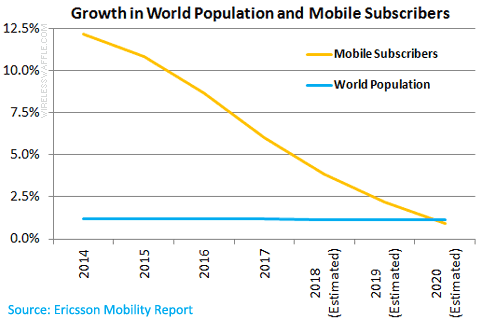Thursday 21 June, 2018, 17:42 - Spectrum Management
 Wireless Waffle regularly peruse published data on all manner of radio and related topics to bring you our often orthogonal analyses of various subjects leading to outcomes that others may not have considered. It is with exactly that kind of hat on, that we were looking at the figures produced by Ericsson in its annual Mobility Report. In the report, they give the number of subscribers with a mobile connection, which in 2017 stood at 5.3 billion, up from 5 billion in 2016. This does not include 'machine' subscriptions, nor multiple subscriptions by the same person (i.e. where someone has a phone and a tablet computer, or a work phone and a personal phone) and therefore represents just the number of actual people with a mobile connection.
Wireless Waffle regularly peruse published data on all manner of radio and related topics to bring you our often orthogonal analyses of various subjects leading to outcomes that others may not have considered. It is with exactly that kind of hat on, that we were looking at the figures produced by Ericsson in its annual Mobility Report. In the report, they give the number of subscribers with a mobile connection, which in 2017 stood at 5.3 billion, up from 5 billion in 2016. This does not include 'machine' subscriptions, nor multiple subscriptions by the same person (i.e. where someone has a phone and a tablet computer, or a work phone and a personal phone) and therefore represents just the number of actual people with a mobile connection.The interesting fact from amongst these statistics is that the growth in new mobile subscribers is slowing, and using forecasting based on the 'it fits a nice curve so is probably right' school of highly advanced bistromathics, by 2020, new additions will have fallen to just 1% more than in the previous year reaching around 5.7 billion. World population growth is forecast to be around 1.15% in the same year reaching around 7.8 billion.

Digging slightly deeper into the figures, what becomes clear is that during 2020, the number of new mobile subscribers will be less than the number of new people on the planet. In 2019, the number of people without a mobile subscription is estimated (by Wireless Waffle) to be 2.08 billion. In 2020 the number of people without a mobile subscription is estimated to be 2.11 billion, or 30 million more.
This is an interesting conclusion. It means that within 2 years, the number of people on the Earth without a mobile subscription will begin to grow. The number of those without access to mobile telecommunications will get bigger. Or put in other terms, the digital divide (between the 'haves' and the 'have nots') will get worse. This appears to be down to two main factors:
 Coverage: Although coverage is still increasing in many countries, it is slowing down. In particular, coverage in rural or remote areas is not changing significantly, as it proves increasingly costly to reach these hard to get to places.
Coverage: Although coverage is still increasing in many countries, it is slowing down. In particular, coverage in rural or remote areas is not changing significantly, as it proves increasingly costly to reach these hard to get to places.- Price: The cost of mobile subscriptions is no longer falling significantly as operators fight to recoup their investments in 3G and 4G. As such, those who can afford a connection already have one, and other than general growth trends increasing the income of the lowest paid, those who cannot afford a connection are unlikely to be able to do so any time soon.
At the same time as the digital divide is set to grow, mobile operators and mobile equipment vendors are hell-bent on introducing new technologies including 5G and millimetre wave. Both these technologies will provide bucket loads of capacity and throughput, but cell sizes are generally going to be limited to a few hundred metres at most, and capacity will be focussed on dense urban areas where there is profit to be made selling such services to data hungry consumers. They are also not cheap and nor will they be incorporated into low-end mobile handsets. The upshot of this is that 5G and millimetre wave technologies will not improve coverage, indeed they will excentuate the urban/rural divide, and they will also do nothing to make services more cost-effective, they will exacurbate the problem.
There is no simple answer to the problems of coverage and price,
 other than mobile operators taking different investment decisions based not necessarily on commercial return, but on providing a public service. Of course they are commercial companies and thus neither obliged nor motivated to become public servants, which is why it might be time for governments to step in. This has happened already in many countries when it comes to investment in fibre, in that a market failure has been identified, and governments have stepped in to fund fibre roll-out to otherwise uneconomical places. The fibre has then been offered on a wholesale basis to anyone who wished to use it.
other than mobile operators taking different investment decisions based not necessarily on commercial return, but on providing a public service. Of course they are commercial companies and thus neither obliged nor motivated to become public servants, which is why it might be time for governments to step in. This has happened already in many countries when it comes to investment in fibre, in that a market failure has been identified, and governments have stepped in to fund fibre roll-out to otherwise uneconomical places. The fibre has then been offered on a wholesale basis to anyone who wished to use it.Maybe the same is now needed for wireless services. The 700 MHz band, for example, is a good candidate to provide rural and remote area coverage at reasonable cost. Instead of auctioning all of the band off to the highest bidder, governments could reserve some (or all) of the band for a national wholesale operator whose target is rural/remote coverage and sell this back to the other operators on a wholesale basis (they could even share the spectrum on a geographic basis with the main operators who could use it in urban/suburban areas). The governments of Mexico and Rwanda are already doing just this, and it makes sense: building just one network in hard to get to places, is, even using basic bistromathics, around four times cheaper than building one network per operator (assuming there are four operators).
One thing that will not solve the problem, is finding yet more radio spectrum for mobile services. Introducing new mobile bands such as those touted at 26 GHz and above, will do absolutely nothing to improve the situation. Today's problem is no longer capacity, it is coverage and price. And spectrum is not the solution, revised government thinking just might be.
Toby
Wednesday 12 September, 2018, 17:45
On a similar note, the GSMA club of mobile operators believes that 80% of people without internet access (3.3 billion people) are actually already covered by a mobile broadband network. It seems the problem is that 3G/4G is too expensive for most of these people.Check out page 17 here: https://www.gsmaintelligence.com/research/?file=8535289e1005eb248a54069d82ceb824&download
